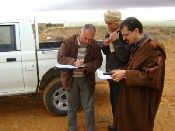| Selecting strategies: Stakeholder Workshop 2 |
 |
|
Results and conclusions from Stakeholder Workshop 2 "Selection and decision on technologies/approaches to be implemented", held in Yanhe River Basin, China, June 2-5, 2008. Authors: Wang Fei, Yang Shangbin, Li Jinpeng, Zhangjia
The workshop methodology was designed and coordinated through Research Theme 3: Potential prevention & mitigation strategies and consisted of three main elements:
Target groups were the same as in the 1st workshop: local stakeholders (land users, representatives of local authorities, local NGOs) and external stakeholders (researchers, development professionals, NGOs, GOs).
As a result of the workshop, the following measures were selected for testing in field experiments.
|
|||||||||||||||||||||||
Study sites

Acknowledgement
The DESIRE project was
|
DESIRE brought together the expertise of
26 international research institutes
and non-governmental organisations.
This website does not necessarily
represent the opinion of the
European Commission. The European
Commission is not responsible for
any use that might be made of the
information contained herein. 






